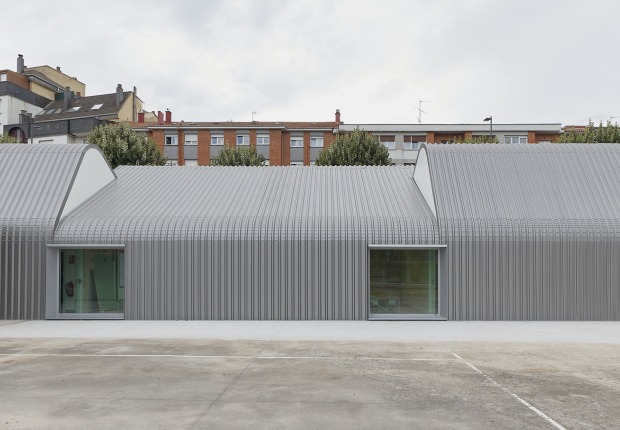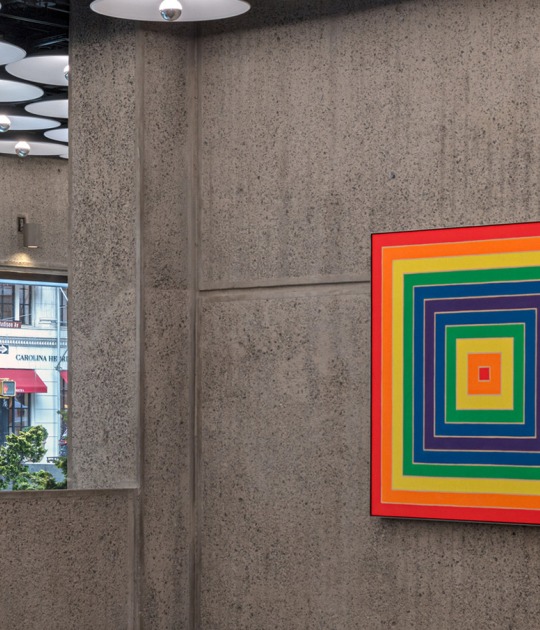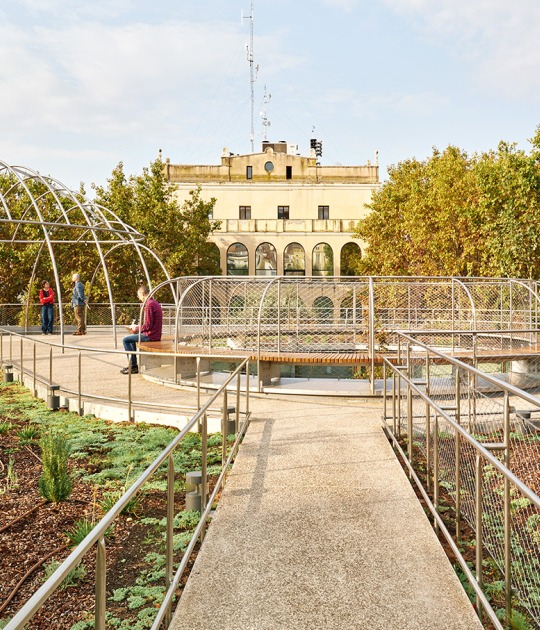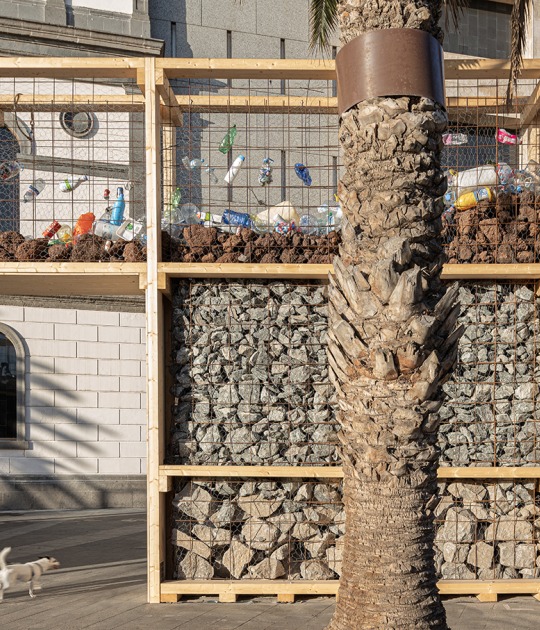The building was designed by Herzog & de Meuron. Acording the clients its clear lines and functionality make it a perfect fit with Roche's established architectural tradition. "Alongside the functionality of the building, its sustainability is also crucially important to Roche. We are proud that Building 1 is one of the most sustainable high-rises in the world.” said Jürg Erismann, Head of the Basel/Kaiseraugst Site. “About 75 percent of the total investment of 550 million francs was awarded to Swiss companies, constituting a significant contribution by Roche to strengthening the regional economy.”
“Whereas externally, Building 1 is in keeping with the architectural idiom set forth by Roche, internally it fulfils the ever-changing demands on a modern and innovative workplace environment. Building 1 is innovative because its inner structure was designed first and foremost with the patterns of movement and communication needs of its occupants in mind.” Quote Pierre de Meuron.
“The media in particular make much of the fact that it’s the tallest building in Switzerland, as well as the tallest Herzog & de Meuron have built to date. However, neither Roche nor we as architects set out to break records. Rather, Building 1 exemplifies our position in the current discourse surrounding the problems of uncontrolled development, both in Basel and throughout Switzerland. In areas where there is already dense urban settlement, the aim should be continued, targeted densification." Quote Jacques Herzo.
Description of the Project by Herzog & De Meuron
Site development
Building 1 is the tallest and most distinctive building on the Roche site in Basel, marking a progression in the development plan that has emerged in logical steps commensurate with the organic growth of the corporation out of the original Hoffmann-La Roche AG industrial complex. The new building is situated in the southern part of the Roche grounds, alongside Building 52, which is currently the highest structure. The continued development of the Roche grounds follows the 2006 plan drawn up by Roche to introduce structural clarity by locating research and development in the northern sector and the Global Corporate Headquarters in the southern sector. Building 1 is the embodiment of that vision of clarity on Grenzacherstrasse. The proposed site is currently flanked to the east and the south by production and research buildings which can be replaced in the course of site development by new office buildings in keeping with the plans.
Highrise typology
In designing the 178m building, the main focus was on developing a highrise typology that visualises and fosters the internal organisation and communication within the various departments. The tower will house approximately 2000 workplaces relating to various departments currently scattered throughout the city. These are to be brought together in one place in a process of so-called “office re-entry”. This will allow the smooth flow of communication between and within the various departments in a way that is not currently possible. Office re-entry involves synergies enabled not only by the convergence of staff from different fields but also by the overall sense of corporate identity which will be enhanced by the integration of staff on the site.
The architecture of Building 1 will express and actively encourage this new potential for communication. It will be flexible and will provide attractive workplaces and infrastructural facilities for the staff. The challenge lies in creating an urban environment rather than a mono-functional office building in which each separate floor is accessed only via one central core.
The building is a 41-storey, 178m tall highrise, tapering towards the top. The local building plan defines the distinctive wedge-shaped form, slanting down towards the west and almost vertical to the east. The zoning envelope is the base for a clear and regularly stepped form with set backs in a two terrace interval to the west and, rising nearly vertically, with subtle and even steps over three floors to the east.
The building is vertically structured by superimposed floor slabs of varying sizes, which are sculpturally expressed on the exterior by horizontal white parapet bands. These parapet bands are typical of the modernism that has characterised the architectural development of Roche since the 1930s, a stylistic influence that still prevails in numerous buildings today. In this respect, Building 1 is a contemporary interpretation of the architectural identity and tradition of Roche.
The simple yet striking shape and the height of the building firmly anchor the Roche grounds within the urban setting. Because of its geometry, Building 1 looks entirely different depending on the angle of view, making it a recognisable landmark for each part of the city from which it is seen. To the south, seen from the Rhine, it appears as a stepped wedge. Depending on the light reflected on the facade, the balustrades and windows merge together to a light volume which dissolve towards the sky. From the east and west, along Grenacherstrasse, it appears as a slender vertical or staggered tower, who’s contours are emphasized by its three dimensional balustrades. Light and shadows emphasise this distinctive impression. At the lower floors the building relates to the street scale by setting back the band windows. Hence, a smooth transition can be achieved between the human scale and the sleek facades to the north and southern side of the building, the urban scale.
Uses
The uses are stacked in accordance with the clearance specifications of the site. The regular stepping provides open-air patio areas that can be accessed from the shared multi-storey communication zones linked by sweeping spiral staircases running over two or three floors. These communication platforms are situated on the east and west sides of the building at various levels. In this way, points of orientation are created on each floor where staff can meet to chat, hold informal meetings, relax or take a break in the lounge areas. The spiral staircases are designed in the architectural tradition of Roche, echoing the elegantly sweeping staircase in Otto R. Salvisberg‘s still widely admired managerial building of 1937. The height of the building ensures that the 2000 workplaces enjoy fine views, while the relatively narrow form allows ideal natural lighting conditions.
The floorplan and structure of the individual floors permit a high degree of versatility in partitioning so that individual offices can be opened up to form open-plan work areas. The glazing in the office areas is complemented by walk-on patio areas in the communication zones, providing outdoor space and natural ventilation.
Areas with a large occupation number, such as the 500-seat auditorium, the staff restaurant as well as the central meeting rooms, are located at the lower level where they are easily accessible by all employees. These areas take the form of a cantilevered volume, clearly marking the main entrance with the large covered outdoor space. The offices and meeting rooms are located from the 5th floor upwards. The top floor is occupied by a cafeteria with outstanding views over Basel and the surrounding area.
Text.- Herzog & de Meuron, September 2015
CREDITS. DATA SHEET.-
Herzog & de Meuron Team.- Partners.- Jacques Herzog, Pierre de Meuron, Stefan Marbach (Partner in Charge).
Project Architects.- Michael Fischer (Associate, Project Director), Stefan Segessenmann (Associate), Barbara Zeleny (Project Manager), Martin Knüsel, Falk Schneemann, Caesar Zumthor-Prado.
Project Team.- Farhad Ahmad, Abdulfatah Adan, Troels Andersen, Juliane Bank, Alexander Bartscher, Axel Beck, Florian Becker, Pascal Bögli, Martin Brandsdal, Ariana Conca, Caetano De Braganca, Dorothee Dietz, Carmen Eichenberger, Felix Fassbinder, Francis Fawcett, Bruce Feng, Jenny Fetveit, Oliver Franke, Timothee Gauvin, Salome Gutscher, Lena Göpfert, Adriana Hernandez, Elisabeth Hinz, Marc Hölscher, Roger Huwyler, Christoph Jantos, Tamara Jechnerer, Victor Julebaek, Leonard Kadid, Evert Klinkenberg, Denis Kolesnikov, Beatus Kopp, Kenzo Krüger-Heyden, Christina Liao, Aron Lorincz, Jana von Mackensen, Alexandre Masse, Nadine Mauritz, Hania Michalska, Melk Nigg, Colm O’Brien, Argel Padilla, Pedro Pena, Holger Rasch, Nathalie Rinne, Hendrik Schikarski, Tilmann Schmidt, Kathrin Schwarz, Jakob Seyboth, Sophie Shiraishi, Merethe T. Skjellvik, Alexander Stern, Michaela Stolcova, Fumiko Takahama, Moritz Thierfelder, Tanja Thomae, Luca Ugolini, Paul Vantieghem, Julie Wagner, Thomas Wagner, Viktor Westerdahl, Gerd Wetzel, Achim Winter, Fen Xiao, Mika Zacharias, Camillo Zanardini, Daniel Zarhy
Client.- F. Hoffmann-La Roche AG, Basel, Switzerland.
Total investment of 550 million Swiss francs
Construction work started in October 2010, shell completed in December 2014
An average of around 550 construction workers were on the building site every day
41 floors
74,200 square metres gross floor area
Significantly exceeds Minergie standard
Building heated entirely with waste heat from the site and cooled with groundwater •Attractive workplace for around 2,000 employees
Modern office infrastructure
500-seat auditorium













































